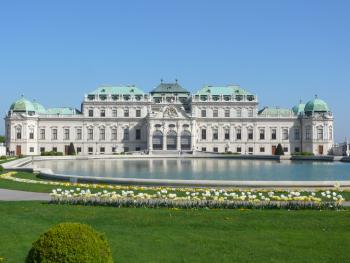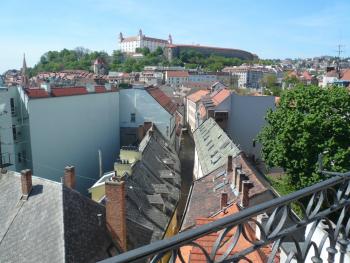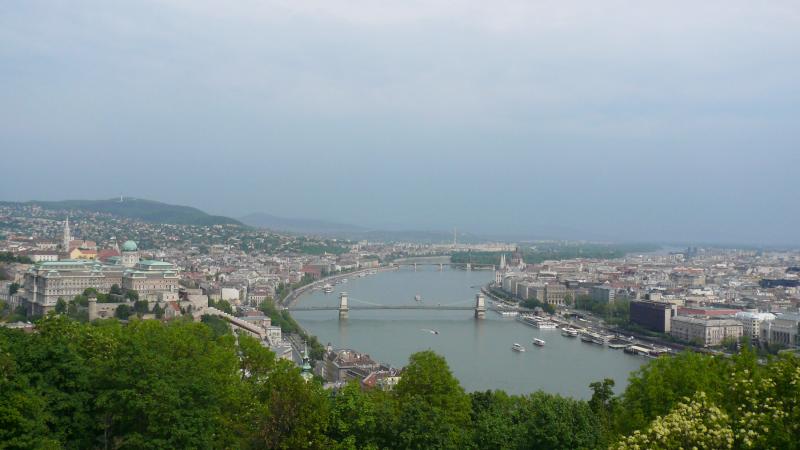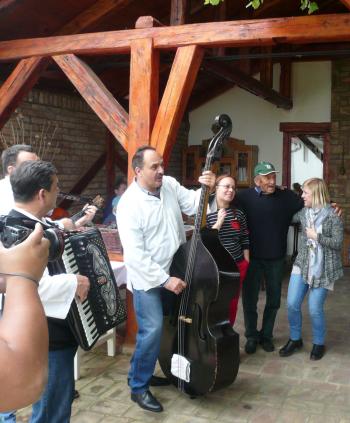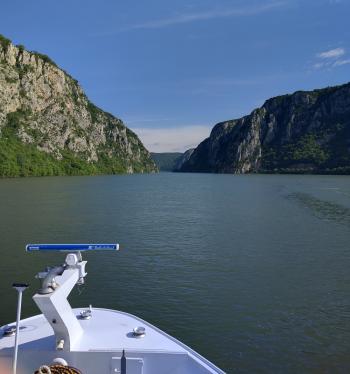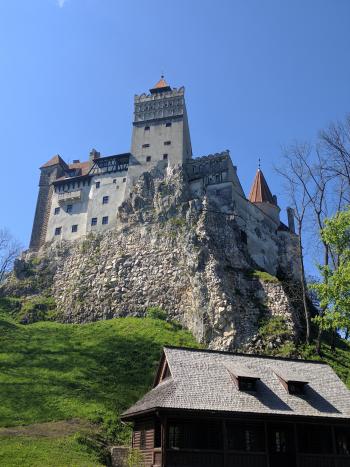Following the Danube — a 7-country river cruise through Europe’s history
This article appears on page 6 of the September 2016 issue.
Throughout its history, the Danube has flowed through dozens of empires, kingdoms and principalities and, now, nations whose independence was won through struggle and endurance. In April-May 2016, I followed its route on an 11-night cruise with Value World Tours* aboard the MS River Navigator.
This “Southern Danube Discovery” cruise, priced from $2,799 to $4,098 per person, double, depending on cabin category, began in Austria and included stops in Slovakia, Hungary, Croatia, Serbia and Bulgaria, ending in Romania.
The English-speaking group that I was a part of was led by Dusan, a happy and energetic leader who has been leading tours with Value World for about 20 years. (He was also generous, lending me a jacket when Budapest’s weather turned frigid overnight.)
My simple cabin included two twin beds, a desk and a small closet, and the bathroom was surprisingly roomy. Also, all the ship’s faucets gave filtered water, so I never had to worry about buying bottled water.
Each port of call included a morning tour, usually by bus and on foot, led by a local guide. These guides would often stay with us to lead optional excursions later in the day.
They were armed with in-depth knowledge of the cities we visited and offered a great deal of insight into the tumultuous history that every city east of Vienna seemed to share. Like Dusan, most of these guides had worked with Value World for years.
Venturing out in Vienna
Our starting port, Vienna, was a city that wore its imperial roots like medals on a military dress coat.
Instead of taking the morning tour, I decided to explore the city with a friend who had come from Berlin to meet me. Our first stop was the Austrian National Library, housed in the Hofburg Palace.
Built by King Charles VI, the library was clearly the product of a wealthy empire. One end of the library, accessible only to scholars and students, was built of gray stone in Baroque and Greek-revival styles. The other end, the entrance to the library’s museum, had an audacious white-plaster façade topped with gilded globes and statues.
The museum is a book lover’s paradise, with two levels of leather-bound books stretching to the painted ceilings. Large windows in the walls and domed roof left little need for electric lighting.
Not wanting to leave Vienna without experiencing café culture, my friend and I ended our explorations with a visit to Café Central (Herrengasse 14), a classic Viennese café with a long history, to enjoy a coffee and the much-recommended Kaiserschmarrn (thick, shredded pancake) with powdered sugar and apple compote (€12, or $13.30). Unfortunately, I found it a bit bland and too heavy to finish.
That night we said “Auf Wiedersehen” to Vienna and “Ahoj!” to Bratislava, Slovakia.
Bratislava
We had only a short time — half a day — in Bratislava, so I tried to make the most of it. After our morning tour of the Old Town and Bratislava Castle, I returned to the area of St. Michael’s Gate, the last- remaining medieval gate in the city, to do a little exploring.
Dusan was an irreplaceable source of local information, and in Bratislava he gave me the first of many suggestions for sightseeing, telling me to check out the Primaciálny palác in the central square.
He was right; it was exactly the kind of place I wanted to visit, and, since there wasn’t so much as a sign directing people to it, I never would have found it without his help.
Inside, I found a smattering of 16th- and 17th-century paintings, including some of Hapsburg royalty, but seeing the very skillfully crafted 17th-century tapestries, which tell the story of Hero and Leander, was the highlight of my visit. These previously forgotten tapestries were discovered behind a wall during a renovation in 1903, so, despite their age, their having been out of the light for so many centuries had kept them looking quite vibrant.
At the end of the palace’s Hall of Mirrors was a great view into the private Chapel of St. Ladislaus.
The palác is still an active city government building, so it may not always be open to the public.
With the time I had left, I visited the Museum of Arms in St. Michael’s Tower. Displays of weaponry greeted me on each level of the tower that I ascended, starting with medieval weaponry and progressing to WWI-era arms and uniforms at the top.
The stairs were very steep and narrow, but at the top I was able to go out onto a walkway for a view across the Old Town.
My €4.30 entrance fee also got me into the apothecary museum just around the corner, which made for a quick but charming visit.
Budapest
The ship docked in Budapest early the next morning, and I awoke to a stunning view of the Liberty Bridge and the Buda side of the river.
The group took a morning bus tour that visited points on both sides of the Danube, including the Fisherman’s Bastion and Budapest’s Statue of Liberty, where our guide carefully maneuvered our group away from clumps of men that she knew included pickpockets and scam artists.
We ended with a quite memorable trip to the Central Market Hall. It was a Saturday, so the market was packed. Vendors displayed colorful boxes of paprika, cured meats, vegetables and mushrooms, and locals roamed the booths, haggling for cabbages or jars of honey.
Upstairs, I found a few interesting food booths, but most vendors were selling souvenirs for tourists.
That afternoon I joined one of the optional tours offered by the cruise, a walking tour of the central city ($15) led by Dusan. The tour took us through pedestrian streets that we were not able to reach in the bus and included some history of the area, specifically about the restored buildings. We did not visit the “typical” tourist spots and, instead, were shown a broader Budapest.
At the end of the walking tour, with a couple of hours to spare before the next activity, I took the opportunity to get lost.
Getting lost in Budapest was harrowing. With countless alleys and side streets, it was never clear which way I was going. Even with my phone’s GPS map trying to guide me, I could not stop walking perpendicular to the way I wanted to go.
Although I was terribly turned around, it worked out a bit in my favor. Coming around a corner, I ran smack into the back of the Dohány Street Synagogue, the largest synagogue in Europe. Dohány Synagogue was definitely on my list, but, as we had found out earlier on the tour, it wasn’t open.
Still an active synagogue, Dohány was closed to nonmembers because of Pesach (Passover), which had started the night before. Nonetheless, just being able to walk around the building, a massive Moorish-style construct, was something special.
Finally I saw the spires of the Liberty Bridge ahead of me and I knew I would make it back to the ship.
Making discoveries
Though the second of our two full days in Budapest was overcast and chilly, I was really looking forward to an entirely free day of exploring.
When I exited the ship, it was raining hard, but it was so windy that my umbrella was practically useless. Weather be damned! I was intent on reaching the Hungarian National Gallery, housed in Buda Castle across the river from the ship and up a steep hill.
I walked across Liberty Bridge, wind driving rain into my face, and made my way to the base of the hill. Getting up the hill on foot wasn’t easy. There were three ways up, and the one I chose was the steepest but possibly the most interesting. (There is a funicular that will take you to the top, for a fee of HUF200, or 70¢.)
A series of steep staircases, walkways and corridors took me up to the south side of the palace castle. From there, I walked around to the front along the top of the wall.
Reaching the entrance of the National Gallery, I found a line reaching well past the door.
On my way around the building, I had noticed a sign reading “Budapest History Museum” above a small, nondescript door (with no line) tucked into a corner of the palace, so I decided to forgo standing in the rain and returned to the History Museum. It turned out to be a fantastic decision.
After paying an entry fee of HUF2,000 ($7), I took a walk through the history of the palace and of the people occupying the area of Budapest.
Much of the first two floors were made up of the original, excavated medieval castle, some of it partially restored. This included numerous fragments of stonework and statues.
The third and fourth floors consisted of artifacts from the Hapsburg period, and the final floor was dedicated to the prehistoric peoples who had lived in the area. It was an absolutely wonderful museum for a history and archaeology buff.
It so happened that I had entered through the museum’s basement entrance, which allowed me to skip the crowds and the gift shop at the main entrance.
As I walked back to the ship across the Chain Bridge, I considered my path. The bridge, itself, was missing large chunks that had rusted away. Along the riverbank, walkways were eroded or missing, replaced with flimsy sheet metal and without a handrail in sight. And all around the city, stairs were steep and pitted… and usually wet. Though I found it charming, it wasn’t exactly easy on the feet.
Later in the afternoon, I went to a little café just around the corner from Dohány Synagogue that I had seen the day before. It was called Café Noé (Wesselényi St. 13, District 7; phone +36 1 787 3842). Specifically, what had drawn my attention to it was a large sign that said “FLODNI, Budapest’s original Jewish pastry.”
Flodni is a traditional Jewish dessert made with layers of pastry, plum jam, walnuts, apple and poppy seed filling, and Noé apparently had the best in town. (The owner and chef, Rachel Raj, was voted by Budapest Week magazine the city’s top pastry chef in 2015.) And, yes, I know how wrong it was that I was eating a Jewish pastry on Passover only two blocks from the biggest synagogue in Europe, but it was the best flodni in town! What choice did I have?
Serbia
After a short stop in Vukovar, Croatia, the River Navigator next docked in Novi Sad, Serbia. Novi Sad was a nice-enough town, but I would discover the real highlights on the optional excursion ($30) offered at this port.
Our guide, Jasmina, was a local student who grew up in the area and had a very firm grasp on how to lead a group.
The first stop was Krušedol Monastery, located in the hills of northern Serbia. The monastery, parts of which date back to the 16th century, was beautiful, especially the awesome frescoes and icons inside the small chapel. (It also was inhabited by some of the sternest, most severe monks I’ve ever seen, not one of whom seemed happy that we were there.)
Our guide had a good rapport with the monks, which came in handy, as she had to lobby on the group’s behalf. Even though the required dress code had been announced to all in the morning, she had to escort away from the sanctuary some tour members who had arrived in shorts.
From Krušedol, we were driven to the town of Sremski Karlovci, in Serbia’s wine country, where we visited the Zivanovic Winery & Beekeeping Museum for a wine and honey tasting. This was the guide’s hometown, and she was a family friend of the Zivanovic family. I don’t drink, but the honey tasting was very good, especially the interesting mixture made from honey and sesame seeds that was like nothing I’d ever tasted.
That night, we arrived in Serbia’s capital. Belgrade is a city that is still recovering from the many, many assaults, bombardments and onslaughts it has suffered over the years. Some buildings destroyed by the NATO bombing of Belgrade in 1999 are just now being torn down.
But it is also very clearly a city that is vital and growing, which was especially evident in Novi Beograd (New Belgrade), across the river from the Old City.
Our morning tour took us to Belgrade Fortress, an enormous construction that towers over the city. Portions of the fortress date back to Roman times, but the majority of the walls were built to defend (unsuccessfully) against the Turks. Today, the fortress is a wide-open park, often filled with locals and their dogs. It also contains a few history museums.
That afternoon, I joined the optional “Serbian Peasant Feast” excursion. My fellow passengers and I went to the small town of Jarak to visit the home of Tosha, a lively, friendly, 81-year-old farmer who, along with his large and accommodating family, had prepared an enormous meal — and gallons of homemade šljivovica, a plum brandy that is Serbia’s national drink — for the group.
The large table of food included all kinds of fresh vegetables, cured meats, cheeses and even a bit of dessert. While we ate, Tosha’s grandson and his band serenaded us with Serbian folk music before our group danced and sang its way back to the buses, with Tosha in the lead.
Along the river
The following day was a sailing day, without any port stops, but that didn’t mean it wouldn’t be eventful. The bulk of the morning was spent motoring through the Iron Gates gorge, an incredibly scenic area of the Danube. On either side of the ship, large granite walls rose dramatically from the water. The sun was shining, so most of the passengers found themselves on deck to take in the entire scene.
We sailed through Romania and on to Bulgaria, where we docked in the town of Vidin. In the vicinity of the port, Vidin looked fairly rundown, but the town does contain a lot of history. There was a shocking amount of Roman artifacts in public spaces, as the area had been an important Roman outpost for centuries. Cenotaphs, monuments and sarcophagi lie scattered in the parks.
One of the more sobering sights in Vidin was the abandoned synagogue. Now just a ruin, this crumbling landmark obviously was once a beautiful building. However, neither WWII nor the Nazis had anything to do with the state of the synagogue. Rather, the Jewish community left for greener pastures in the ’50s, leaving no one to care for it.
After getting to know Vidin, we got on a bus and headed for the Belogradchik Rocks and the famous fortress there. We drove on uneven roads that were never meant for buses and past towns and settlements that were almost impossibly rustic. It was an interesting trip.
Our guide for the day, Manuela, was a schoolteacher with a wealth of knowledge of the area. She was also one of the few guides who was old enough to have spent some of her adulthood under Communism.
Throughout the long bus rides we took that day, she shared with us (at the request of some of the travelers) how things have changed, for better and for worse.
All of the guides we had who had lived through Communism expressed some nostalgia for those times, but she explained why better than any of the others. She also explained how much harm Communism had done to the people of Bulgaria and how social freedoms and membership in the European Union has benefited the country. It was a very educational bus ride.
As our bus descended into a verdant valley, our destination could clearly be seen.
The Belogradchik Rocks consist of a wide geographical area that was once at the bottom of a sea. The weathering of iron-rich rocks has created huge, fascinating rock spires. In the middle of the most impressive of these formations is a stone gate leading to a “fortress.” To see it, though, you have to use your imagination, since almost all of the internal structures had been made of wood, which has rotted away.
This trip was not easy in any way, neither the bus ride nor the hike. The fortress was reached by climbing about 200 feet of steep steps — and that was the easy part! Within the gate, most of the steps, carved out of stone hundreds of years ago, are now decomposing. There were also newly constructed steps, but they were so steep that even a mountain goat would struggle to climb down safely. That said, if you can make it, the view from the top is exquisite.
Romania
This was to be our last night aboard the River Navigator. The next day would be the beginning of our 2-night “Dracula” extension in Romania ($499 per person, sharing), which would be by bus. We said good-bye to Dusan, who was returning to his home in Serbia, and met Liviu, our guide in Romania.
Liviu was a real character and a great asset. Like Dusan, he was a proponent of independent exploration and would always have a place in mind when I told him what I was interested in seeing.
He was also incredibly helpful, making sure that my dietary restrictions were met at restaurants when we had group meals.
Of all of our guides, he probably had the most stories… about Communism, about cultures and about religion.
The timing of our visit to Romania was both a blessing and a curse. We arrived on Saturday, April 30, and in 2016 Orthodox Easter was celebrated on Sunday, May 1.
In this predominantly Eastern Orthodox nation, Easter is the most important holiday of the year. It was a treat to see the Romanian people preparing for and celebrating this significant day, but it also meant that everything was closed, so no museums, no shops, no cafés.
We traveled from the port through Bucharest and into the mountains to the city of Bras¸ov, where we stayed at the Aro Palace Hotel, a 5-star accommodation.
Bras¸ov is a resort town that reminded me very much of Aspen, Colorado. It was clean, bustling and quite pretty.
The old part of the city, just two blocks from our hotel, was filled with shops, restaurants and buildings marked with historical-site plaques. It also had its fair share of churches.
Most noticeable was the massive Gothic cathedral in the middle of town, which was lit at night in such a way that it looked like the walls went up forever. I became quite obsessed with it.
From Bras¸ov we went to the nearby city of Bran, home to Bran Castle. Often called “Dracula’s Castle,” as some say this is the castle that most closely matches Bram Stoker’s description of Dracula’s castle in his eponymous book, it is a charming, compact castle in its own right. Like the rest of the sites we visited, it required a lot of climbing and head-bumping.
Unfortunately, the castle staff has embraced the Dracula mythology (though there’s no credible connection to Vlad Dracul, the namesake of the book’s main character), and many of the displays reflect this, but there were plenty of refurbished rooms inside that showed what it was really like when occupied.
For our final night in Bras¸ov, we were treated to dinner and a show at Cerbul Carpatin, a restaurant housed in a building that dates back to the founding of the city. As we ate, dancers and musicians performed Romanian routines, pulling diners onto the floor to join them. (Yes, I was coerced onto the floor, and, no, there aren’t pictures. No one wants to see that!)
On our way back to Bucharest the next day, we stopped at the town of Sinaia to tour Peles¸ Castle. More akin to a mansion than a castle, it was built in a kind of Tudor/Alpine style. Peles¸ was the summer home for the Romanian royal family until they were forced to abdicate after WWII.
To visit Peles¸ Castle, you must be on a guided tour, which lasts about 40 minutes. Only a handful of people are allowed in at a time. It is an incredibly popular site for visitors from all over the world, and the grounds became crowded with people trying to push their way in each time the door opened to let in the next group. If you’re with a large number of people, you might find yourself separated from your group.
The interior of the castle was quite impressive. The highlight was, undoubtedly, the entrance atrium with its retractable stained-glass ceiling, still operating on its original mechanism. Unfortunately, photography is allowed only if you pay a fee of RON32 (almost $8).
Echoes from the past
Returning to Bucharest, our group took a short driving tour of the city, including a fantastic history lesson from Liviu, a man who had lived through some of the most important moments in Romania’s recent history.
We then checked into the Novotel Bucharest.
Tip — Do not try to use the stairs at this hotel. Considering the line of people waiting for the elevator, I decided to save time and simply carry my bag to my third-floor room. Big mistake! The doors in the stairwell did not have any handles to allow access to the guest floors, so I had to take the stairs to the second subbasement, then take a service elevator to the third floor.
On our final night, we had time to explore the city independently. However, I had to be up at 3 the next morning, so I decided against spending much time wandering the city. There was one site that I refused to leave without seeing, however: the balcony where Nicolae Ceaușescu made his final speech, conveniently located near the hotel.
On Dec. 21, 1989, a number of workers were bused to Palace Square (now Revolution Square) to “cheer” the dictator during his annual “state of the party” speech.
A few days before, Ceaușescu had ordered the army and secret police to break up a protest in the town of Timișoara, and civilians were killed. The men bused to the square to cheer were keenly aware of this, and tensions were high.
During the speech, members of the crowd began to boo and hiss at Ceaușescu, an unheard-of act. As the crowd’s confidence (and volume) grew, Ceaușescu and his advisors retreated into the building. Thinking the protests had been quelled, he gave a speech the next day but soon realized he had to flee, which he did by helicopter. He and his wife were captured shortly thereafter, and on Dec. 25 they were executed for crimes against the Romanian people.
A video of the first speech, which had been broadcast live across Romania, is available on YouTube. I recommend watching it. There are precious few chances to see the moment when a megalomaniac suddenly realizes that he is completely powerless. To see a people, an entire nation, win their freedom from a despot.
And I was standing just in front of that same balcony, in the same spot that a Romanian worker finally stood up to his or her tormentor and booed.
Such a small balcony, a scant 12 feet off the ground (it looks so much higher in the video), it jutted from the first floor of a squat building in the corner of a nondescript square. And, yet, a palpable sense of the moment remained.
It was a fitting end to this trip through the former Iron Curtain. F
*Dan Barr was a guest of Value World Tours (Fountain Valley, CA; 800/795-1633, rivercruises.net).

